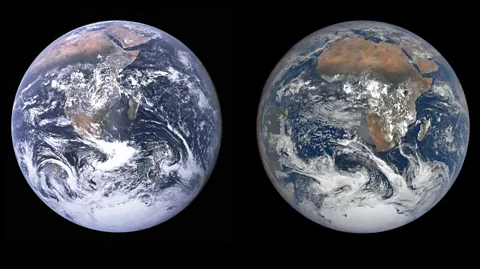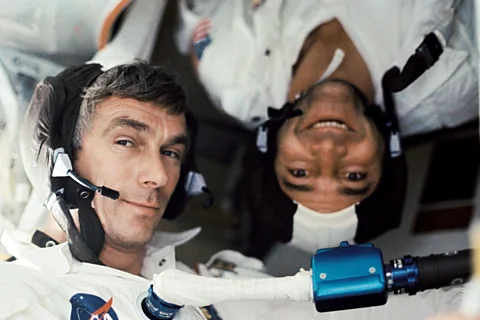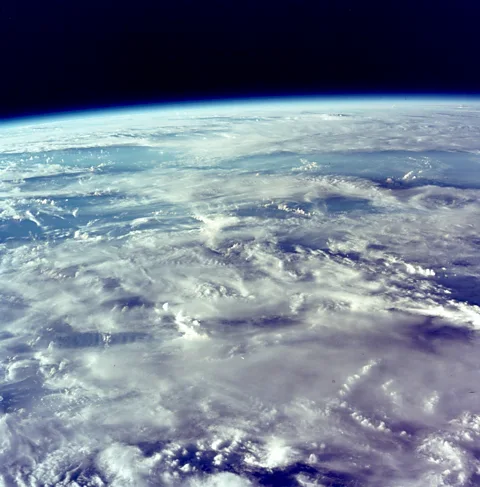How 50 years of climate change has changed the face of the 'Blue Marble' from space
 Nasa
NasaThe "Blue Marble" was the first photograph of the whole Earth and the only one ever taken by a human. Fifty years on, new images of the planet reveal visible changes to the Earth's surface.
"I'll tell you," said astronaut Harrison Schmitt as the Apollo 17 hurtled towards the Moon, "if there ever was a fragile-appearing piece of blue in space, it's the Earth right now".
It was Thursday 7 December 1972, that humanity got its first look at our planet as a whole. In that moment, the photograph "The Blue Marble" was taken – one which changed the way we saw our world.
"I can see the lights of southern California, Bob," said Schmitt to ground control about one and a half hours into the flight. "Man's field of stars on the Earth is competing with the heavens."
The crew of the Apollo 17 – commander Eugene Cernan, command module pilot Ronald Evans and lunar module pilot Harrison "Jack" Schmitt – were watching their home recede into the distance as they journeyed into space for the last manned mission to the Moon.
Looking back towards the Earth, Cernan commented: "the clouds seem to be very artistic, very picturesque. Some in clockwise rotating fashion… but appear to be… very thin where you can… see through those clouds to the blue water below."
It is an enduring image of the beauty but also the vulnerability of our planet – adrift as it is in the vastness of the Universe, which hosts no other signs of life that we have been able to detect to date. But ours is also a planet of great change. The tectonic movements that shift the landmasses move too slow for our eyes to notice. Yet another force – humanity itself – has been reshaping our planet at a pace that we can see. Urbanisation, deforestation, pollution and greenhouse gas emissions are altering the way the Earth looks. So how, over the 50 years since that iconic image was taken, has the Blue Marble changed?
 Nasa
NasaThose first images of the Blue Marble were taken by the crew, who ed the onboard camera – a hand-held analogue Hasselblad 500 EL loaded with 70mm Kodak film – between them, captivated by the sight of the Earth from space.
"All the images captured with Hasselblads are spectacularly clear and bright," says Jennifer Levasseur, curator at the Smithsonian National Air and Space Museum in Washington DC.
The camera was specially modified for use in space, she adds. Glues, lubricants, moving parts and batteries could all cause problems or fail when exposed to the extremes of hot and cold in space. It was also given a large square shutter-release button so the crew could use it while wearing their cumbersome spacesuits.
"The other major modification, was the removal of the viewing screen – because it's extra glass," Levasseur says, The astronauts, "had to learn how to take pictures without being able to see anything", she says. "Without a viewfinder, you can't see what you're taking."
 Nasa
NasaTaking photos, says Levasseur, was planned meticulously and written into the mission plan. "They had known previous launches wouldn't give them whole Earth, but on this one the whole Earth would be entirely illuminated by the light of the Sun."
It was around five hours and 20 minutes into the flight that the crew got their first glimpse of the entire planet. The crew were starting to get ready for bed, zipping into their sleeping bags. It was their first moment of downtime since the launch.
"I suppose we're seeing as 100% full Earth as we'll ever see," said Cernan. "Bob, it's these kind of views that stick with you forever… There's no strings holding it up either. It's out there all by itself."
The Blue Marble image was captured at around 29,000km (18,000 miles) from Earth, as the Sun lit up the globe from behind the Apollo 17.
Almost six hours into the flight, Schmitt laughed. "The problem with looking at the Earth, particularly Antarctica, is it's too bright," he said, "And so I'm using my sunglasses through the monocular".
Back home, it was nearing 05:00 at the Johnson Space Center in Houston, Texas, and ground control was quiet. "I'm not keeping you awake, am I, Bob">window._taboola = window._taboola || []; _taboola.push({ mode: 'alternating-thumbnails-a', container: 'taboola-below-article', placement: 'Below Article', target_type: 'mix' });
